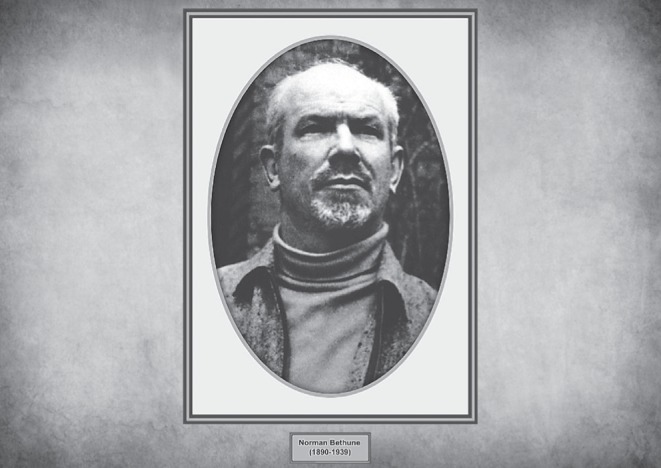It is an enormously difficult task to write about the medical life of Henry Norman Bethune (1890–1939) (Figure) who was one of the most exciting and incredible thoracic surgeons Canada has ever produced. In fact, the late Alexander Walt once categorized him as the world’s best-known surgeon (1). In the social sense, he had a difficult personality, but yet he was deeply caring about the plight of his patients. Professionally, he could be ingenious, thoughtful and effective but, at the same time, could also be abrasive and controversial, especially in the operating room where he often performed surgery with a certain calculated flamboyance. He was an innovative surgeon and his research work was productive. In the People’s Republic of China, he is idolized and, to this day, is still the only foreigner ever to become a national hero in that country. In Canada, his standing has long been tainted by his unconventional personality, his membership in the Communist party and his advocacy of socialized medicine.

Henry Norman Bethune was born March, 3, 1890 in Gravenhurst, Ontario, a small lumbering town 160 km north of Toronto. His paternal ancestry originated from Scotland and both of his parents were Presbyterian ministers highly motivated toward the correction of social injustice. In 1912, he entered medical school at the University of Toronto (U of T, Toronto, Ontario) but decided to interrupt his studies at the outbreak of World War I. After sustaining a severe shrapnel leg wound in the battle of Ypres in Belgium, he was sent back to Canada and completed a crash course in Medicine at the U of T from which he graduated in 1916. Of note, one of his classmates was Frederick Banting, who was to receive the 1923 Nobel prize in medicine for his discovery of insulin.
After suffering from tuberculosis in the fall of 1926, he joined Edward Archibald’s Thoracic Surgery service at the Royal Victoria Hospital (Royal Vic) in Montreal (Quebec), first as a fellow and in 1930 as a clinical assistant. Although he was never provided with a license to practice surgery in Quebec, he was allowed to work at the Royal Vic and, soon, his scientific contributions gained worldwide attention. These included the design of the Bethune rib shears and pneumothorax apparatus and the description of the Bethune method of producing pleural symphysis by talc poudrage. He also designed most of the thoracic surgical instruments used at the time and, in his publication (2), Bethune wrote the following:
The instruments and apparatus about to be described are the survivors of as many more again ill-conceived or immature ideas.
He was a recognized figure at surgical meetings, where his dressing and anti-establishment behaviour stimulated as much discussion as did his presentations.
In 1932, Edward Archibald’s increasing irritation with Bethune’s frequent and pointed criticisms suggested the need for a change and Bethune accepted the position of Chief of Bronchoscopy and Thoracic Surgery at l’Hôpital du Sacré-Coeur, located just outside Montreal. At the time, Canada and the world were in the depths of the depression and Bethune believed strongly that if poverty could be eliminated, tuberculosis would disappear. He freely provided his services to the poor and would frequently bring food, clothing and medicine to his patients. He was way ahead of his time in using radio broadcasts for public education on tuberculosis. After a trip to Russia in the summer of 1935, he joined the Communist party of Canada and, at around the same time, began a crusade to reform the Canadian Health Care System which he thought was “incredibly backward”. He decried the fact that doctors should benefit from a person’s illness and demanded free health care for all and salary for doctors.
In July 1936, the outbreak of the Civil War in Spain gave Bethune the opportunity to fight directly against the Fascist onslaught. In October, he sailed from Quebec City to Madrid, where he organized the first mobile blood transfusion unit (Servicio Canadiense de Transfusion de Sangre al Frente) to function in forward battle zones. The paramedics who were created during World War II became an extension of his ideas.
In October 1937, Bethune recognized that the Sino-Japanese war in the most populous country in the world was to be a momentous event and was able to convince the Canadian and US communist parties to send him to China to organize medical care for Mao Tse-Tung’s Eight Route Army. He resumed performing surgery after two years without having performed any operating. He understood that more doctors and nurses were needed and he took young peasants, whom he called “Barefoot Doctors (Docteurs aux Pieds Nus)”, and graduated them in one year for doctors and six months for nurses. He laid the groundwork for a medical school, wrote textbooks, and designed operating equipment that could be packed in wood boxes and transported on the back of three mules onto the battlefield. He won the admiration of the Chinese people by accepting their customs, sleeping in their homes and donating his own blood without hesitation.
Bethune died of septicemia on November 12, 1939, only 18 months after his arrival in China. On December 21, 1939, Mao Tse-Tung wrote the following eulogy to his memory:
Comrade Norman Bethune… died a martyr at his post… his utter devotion to others without any thought of self… the art of healing was his profession… his example is an excellent lesson.
Even now, this eulogy is memorized by all school children in China.
The full-length article can be viewed at the Journal’s website at www.pulsus.com
REFERENCES
- 1.Walt AJ. The world’s best-known surgeon. Surgery. 1983;94:582–90. [PubMed] [Google Scholar]
- 2.Bethune N. Some new thoracic surgical instruments. Can Med Assoc J. 1936;35:656–62. [PMC free article] [PubMed] [Google Scholar]


